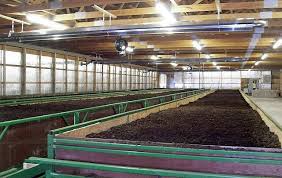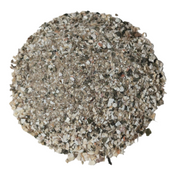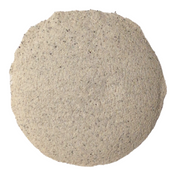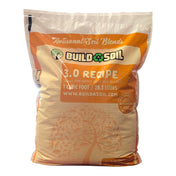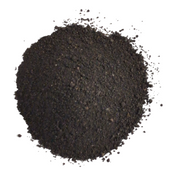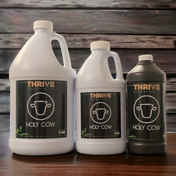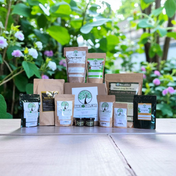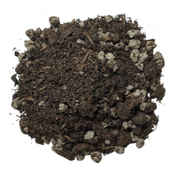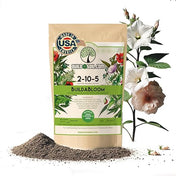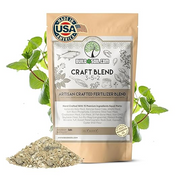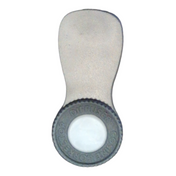What should I look for when buying worm castings or vermicompost?
There is so much BS in the worm game that purchasing quality products and learning about making your own castings can be quite confusing.
You'll see many advertisers using claims like:


The intended end use of a vermicomposted waste helps to determine which of its characteristics may be important in assessing its quality, so it is important to list all of the potential quality criteria for vermicomposts and how they may be assessed. When specifying details of a vermicomposting operation, or evaluating vermicompost products, information about certain aspects of the vermicomposting process may be important. The vermicomposting system used (e.g., bin, windrow, wedge, continuous-flow reactor system, etc.) should be specified, as should the primary raw materials (feedstocks). Differences in process types and raw materials have been shown to have a very strong influence on the quality of the end product and its suitability for particular applications and value (Edwards and Arancon 2004). Any preprocessing, such as leaching or precomposting, should also be described, since this may have considerable effects on qualities such as available nutrient content, contamination with viable weed seeds, or human pathogens. Any amendments with inorganic materials made during the vermicomposting process, such as application of fertilizers, lime, sulfur, and so on, should also be noted, since these may have effects on the final chemical characteristics of the vermicompost, as well as possibly affecting its certification as an “organic” material.
Other information essential for characterizing a vermicomposting operation includes an accurate assessment of the earthworm species used and the average population density in the system, the processing time (material throughput) for a particular batch, and the duration of storage of processed material or vermicomposts.
All of these can affect the quality, stability, and maturity of the resulting product. As already mentioned, the rate of material throughput per total weight of earthworms may be a very important criterion for classifying and registering vermicomposting operations and their resulting vermicomposts.
So how do these "Worm Castings" companies produce a "Pure Castings" product that looks like black coffee grounds?
Here is an inside look at a very popular worm casting production model.
Producers using this system may not know better and will claim it's the best, but common sense will tell you otherwise. When making anything from scratch, the best ingredients will make the best outcome. For making worm castings the worm farmer should only be recycling waste not buying new ingredients to use like peat moss, that is just a waste! Why harvest a peat bog just to make castings when the best vermicompost comes from worms fed thermophilic compost?
Here is a quote from a Worm Farmer named Patrick G. Perry. on Pure Castings:
Here are the specifics on the above posts:
ADVANCED SECTION
#1: Solids Composition (Organic Matter, Ash, and Inert Materials)
A fundamental measure of vermicompost’s physical composition is its organic-
matter content. In reality, this measure provides only a very crude indication of the overall stability of the material. However, the portion of the organic matter that is not completely stabilized (i.e., the biodegradable organic matter) does represent an important property, since it provides the energy sources for biological activity in the soil and is the source of potentially mineralizable nutrients. In a finished vermicompost, the organic-matter content should be greater than 20–25% (but probably less than 50%). The ash content is simply the nonvolatile solids of the compost, excluding inert particulate materials such as glass, metal, plastic, gravel, and large clay aggregates. In high-quality vermicomposts, contamination with inert materials should be very low, less than 0.5–1.0% by weight.
and Aggregate Stability
Bulk density is an important physical property of vermicomposts that influences
other factors critical to plant growth, such as porosity, aeration, moisture-holding capacity, and so on. The final bulk density of a vermicompost depends, to some extent, on the degree of compression within a container or other mix but can be specified in standard ways that provide information for evaluating the properties of such mixes. The total extent of pore space (as a percentage of volume) within a material is also an important characteristic affecting aeration and water relations. For organic materials suitable for potting media, pore space should occupy 70–80% of the total volume. High bulk density usually has the disadvantage of increasing the transport cost of the container medium, and reducing porosity and air capacity, which should be avoided as far as possible in commercial culture media. However, very low bulk density can cause excessive aeration of the substrate and concomitantly a decline in available water. Hence, de Boodt and Verdonck (1972) proposed optimum physical properties for an ideal substrate for plant growth: as a minimum 85% total porosity, container capacity between 55 and 75%, and air space between 20 and 30%.
The percentage container capacity of vermicompost can be defined as the percentage
by volume of micropores that remain filled with water after a saturated substrate has drained (Beeson 1996), The percentage air space (10.04%) of the vermicompost
can be defined as the percentage by volume of air-filled macropores in a saturated substrate (Beeson 1996). The percentage total porosity is the sum of air-filled macropores and water-filled micropores in a saturated substrate. Upon substitution
of MM 360 with pig manure vermicompost, the bulk densities of the potting mixtures
increased with the increasing proportions of vermicompost substituted for MM 360, and this led to gradual decreases in the total porosity, changed the pore space distribution within the container medium, and resulted in decreased air space
and increased water retention (Table 18.1).
Because of the high degree of particle size decrease by grinding of organic matter
in the earthworm gizzards, as well as mixing and ingestion of particles by earthworms, that occurs during the vermicomposting process, high-quality vermicomposts should typically have a relatively fine maximum particle size (less than 0.2 mm (0.007 in) diameter). It is probable that during efficient vermicomposting all of the organic matter may pass several times through the earthworm guts since earthworm can clear their guts in a few hours. Furthermore, the arrangement of individual particles in a potting medium or soil mixture determines the overall bulk density of a material as well as the size and continuity of pores between the particles. For many uses of vermicomposts, it should be essential to specify their composition, in relation to effectiveness and standardization, with regard to the distribution of particles (by weight) into different size classes. Just as important as the size distribution of water-stable aggregates in dry vermicomposts is the degree of stability of these aggregates once they are remoistened. Large aggregates may break down when wet, clogging pores and affecting the quality of a mixture. Aggregates’ water stability can be measured in standard ways and may need to be specified for some uses of vermicompost.
but moisture contents may vary widely in finished vermicomposts, probably without substantially affecting their overall quality or storage potential. Nevertheless, very wet materials can be expensive to transport because of excess weight and can be difficult or messy to handle. Of course, moisture contents can also have a major impact on the value of vermicomposts that are sold by weight. Hence, it has became more common to market vermicomposts by volume, such as by the cubic yard or cubic meter. At the same time, materials that are too dry may have problems with rewetting and may suffer some reduction in plant disease suppressiveness due to changes in the composition of the microbial community, and this may affect other beneficial qualities dependent on the structure and composition of the soil food web. Some specific applications, which include blending into container media or in specialized soil mixtures, may require relatively narrow ranges of moisture in vermicomposts. Generally, acceptable moisture contents range from 30 to 50%.
Whereas the moisture content of a vermicompost can be modified by adding water or by drying, the capacity of a material to retain moisture is more or less fixed. The water-holding capacity of a material (often called container capacity) is defined as the amount of water that is retained after allowing a saturated material to drain freely (usually for 12–24 hours; also more specifically defined as moisture at −1/3 bar tension). However, this moisture is actually comprised of two components: (a) available water that plants can use and (b) unavailable water that is tightly retained to soil particles and is released at water tensions greater than the permanent wilting point of the plant (−15 bars). Specification of both the total and available waterholding capacity can be especially important for vermicompost end uses involving container media. A useful way of expressing the water relations of a material is to determine its moisture-retention curve, that is, a plot of the percentage moisture of a material at different water tensions, ranging from below the permanent wilting point to complete saturation. Such a curve allows calculation and assessment of the water-retention characteristics of different mixtures of container media or soil containing vermicomposts and other ingredients.
#1 Acidity
The acidity of a potting medium or soil has a dominant influence on many aspects of fertility and plant growth. Acceptable pH values of potting media or soils for plant growth range from 5.5 to 8.0, but preferred values range from 6.0 to 7.0. However, individual plant species may have much narrower preferred pH ranges. Vermicomposts vary in pH values depending on the parent organic materials from which they are produced; that is, vermicomposts produced from sheep manure had a pH of 8.6 (Gutierrez-Miceli et al. 2007), vermicomposts from cattle manure had a pH of 6.0 (Jordao et al. 2002) and 6.7 (Alves et al. 2001), vermicomposts from pig manure had pH of 5.7 (Atiyeh et al. 2002) and pH 5.3 (Atiyeh et al. 2001), and vermicomposts from sewage sludge had pH 7.2 (Masciandaro et al. 2002). Perhaps even more important than the pH of a vermicompost is its buffering capacity— the amount of base or acid necessary to increase or decrease the pH by one unit.
Knowledge of the buffering capacity is essential for formulating potting media or
soil mixtures to precise specifications. In alkaline vermicomposts specification of the CaCO3 (lime) content may also be appropriate.
The negative surface charge of organic materials provides sites for retention of
nutrient cations. An adequate cation-exchange capacity for vermicomposts should be
in the range of 50–100 meq/L.
The total concentration of salts (mineral anions and cations) can reach levels in vermicomposts that inhibit plant growth or are toxic to plants, particularly when vermicompost is produced from animal manure feedstocks. High soluble salt concentrations are a common problem with many composts and can be a concern for vermicomposts as well. Soluble salt concentrations (measured as electrical conductivity) in saturated extracts of high-quality plant growth media should not exceed 1–2 dS/m (100–200 mS/m) for sensitive plants and seedlings and 2–3 dS/m (200–300 mS/m) for established plants. Furthermore, the concentration of Na is a particularly important factor influencing potential damage to plants and should be specified if possible. In
some cases, the damaging effect of high soluble salt concentrations may be lessened if Ca is the dominant cation. Usually, vermicomposts have low salt contents because earthworm activity is inhibited at concentrations above 0.5% (Edwards and Arancon 2004) Pig manure vermicompost had an electrical conductivity of 322 mS/m (Table 18.2; Atiyeh et al. 2001). Upon the substitution of 5%, 10%, 25%, 50%, and 100% pig manure vermicompost into Metro-Mix 360, the electrical conductivity of the container media increased linearly with the increasing concentrations of vermicompost.
The C:N ratio is one of the most widely used and potentially useful indicators of the stability of organic materials such as composts and vermicomposts. The C:N ratio of microorganisms is generally between 15 and 25, and the C:N ratio of humus is around 11–12. Material that has been sufficiently stabilized will typically have C:N ratios below 20–22. C:N ratios much higher than this may indicate the presence of bioavailable carbon and therefore material that is not completely stabilized. Changes in the C:N ratio from the raw material feedstock to finished product may be as important as the absolute final value, since nitrogen-rich products may not necessarily be completely stabilized, even though their C:N ratios may be low.
Along with total N, it may be necessary to specify the total content as well as the form of P and K in a finished vermicompost as an indication of its overall macronutrient value. In many U.S. states, it is necessary to state the minimum contents of N, P (as phosphate), and K (as potash) on the label to be able to market vermicomposts as organic fertilizers or soil amendments. Generally, P contents of more than 0.5% are desirable. However, some plants, particularly seedlings in containers, are sensitive to high P concentrations. Container media for sensitive plants should have less than 0.1% total P.
The total contents of Ca, Mg, S, and Bo should also be specified in those situations
where the nutrient value of vermicompost is important. Typical values of these
elements in pig manure vermicomposts are presented in Table 18.2.
In vermicomposts, it is very common for NO3 to be high relative to NH4. In saturated extracts of container media, total inorganic N concentrations should be greater than 100 mg−1. However, concentrations of NH4-N should not exceed 300 mg−1, and concentrations of N03 are considered to be adequate between 100–200 mg−1. In vermicomposts, NH4-N should not be more than 10% of the total N or 0.04% of the total dry weight. Nitrate should be a major component of the inorganic N, with N03-N to NH4N ratios greater than or equal to 0.14.
In many cases, the micronutrient value of organic amendments such as vermicomposts to soil or container media may be as important as the macronutrient content. Vermicomposts typically contain adequate amounts of most micronutrients (see Table 18.2). Humic substances in vermicomposts may be important chelating agents that enhance the availability of some micronutrients. In some situations, an overabundance of particular micronutrient elements may lead to plant toxicity problems.
Although total and extractable nutrient concentrations can provide important information on the overall nutrient status of vermicomposts, nutrient availability to plants is in fact a dynamic process. An understanding of the overall nutrientsupplying capability of a vermicompost, based on its nutrient-release characteristics, may be as important or more important than the size of total or extractable pools of nutrients. Numerous methods can provide information on the nutrient-release characteristics of organic materials in media or soil mixes. Most of these require incubation of the materials for weeks or months and are therefore too expensive to conduct on a routine basis. However, comparative information on the release characteristics
of different mixtures may help in making decisions about which material to use. However, in general, a container-media mix should contain enough nutrients for the first 1 or 2 weeks. It has also been suggested that soil amendments such as vermicomposts should be sufficient to supply complete minor nutrients for a single growing season.
#9 Heavy Metal Contamination
Most vermicomposts produced from food waste, paper waste, animal manures, or plant wastes are unlikely to be contaminated by heavy metals. The most common metals that may occur in vermicomposts are lead (Pb), mercury (Hg), cadmium (Cd), chromium (Cr), molybdenum (Mo), and Zinc (Zn), when the feedstocks are from unusual sources, especially sewage sludges and biosolids (see Chapter 17 and Table 18.3).
Unlike thermophilic composting, temperatures sufficient to kill pathogenic microorganisms are not usually attained during the vermicomposting process. Nevertheless, although the precise mechanisms are not known, there is growing evidence that the vermicomposting process can lead to effective human pathogen elimination and sanitization of the processed material (see Chapter 16) (Eastman et al. 2001). Clearly the type of feedstock is an important factor in assessing the risk of vermicompost contamination with human pathogens. Some “clean” materials, such as paper or food-processing wastes, that are not contaminated with human
pathogens initially may be a much less serious concern than biosolids or animal manures with high contaminant loads. Vermicomposts should meet the same health standards as thermophilic composts with regard to human pathogens (see Chapter 16) In some cases, preprocessing of feedstocks using conventional thermophilic composting for up to 14 days may be needed to ensure adequate human pathogen reduction. Alternatively, posttreatment with steam sterilization, fumigation, or some other treatment could reliably eliminate pathogens. However, such post-treatments would also kill most or all of the beneficial microorganisms that can add substantial
value to the final product, so this is not recommended. Until we know more about the vermicomposting process in relation to pathogen reduction, it is not possible to specify “best management practices,” as can be done with thermophilic composting based on practical and scientific experience and Environmental Protection Agency (EPA) regulation. Therefore, in some cases, it may be necessary to rely on frequent pathogen testing of vermicomposts to ensure compliance with acceptable EPA health standards. The EPA requires virtual elimination of coliform bacteria, Salmonella, enteric viruses, and helminth ova for material classified for class A land disposal (EPA 1980, 1999).
Research has shown that some enzyme activities are correlated with overall microbial activity, soil fertility, plant growth, and plant disease resistance. Dehydrogenase enzyme activity is often used as a parameter of the microbial activity of composts (Forster et al. 1993). During vermicomposting, earthworms enhance selectively the activities of enzymes such as invertase, urease, and alkaline phosphatases, which are of microbial origin. Measurement of enzymatic activities could constitute one of the key measurements in determining the overall microbial activity of the vermicomposts.
It is not uncommon for soil- and compost-testing labs to provide information on populations and activity of selected soil microorganisms in samples of composts or vermicomposts or vermicompost-amended soil. It is generally presumed that the larger the total populations of microorganisms in composts or vermicomposts, the better. In properly prepared thermophilic composts, most microorganisms and decomposer fauna are killed during the high-temperature (thermophilic) phase. Although many microorganisms may recolonize during a lower-temperature curing phase, rates of recolonization may vary, and this process is rarely intentionally managed (with the exception of a few compost products that are purposely inoculated with selected species of microorganisms known to be involved in plant disease suppression). In vermicomposts, however, moderate (mesophilic) temperatures must be maintained, or the earthworms will become inactive, flee, or die. Although populations of some sensitive organisms may be reduced drastically or eliminated during vermicomposting, the substrate maintains an active and complex community of decomposer organisms, which, in addition to earthworms, may include enchytraeids, nematodes, springtails (Collembola), mites (Acarina), protozoans, and innumerable microorganisms. Even if it is necessary to precompost some materials to sanitize them before processing with earthworms, because active earthworm beds are normally teeming with this enormous variety of microorganisms and invertebrates, they may be ideal sites for complete and efficient reinoculation of precomposted materials with entire complex communities of beneficial soil organisms. This may be especially important for container media and in soils that are intensively chemically managed and/or impoverished in biological activity. There is good evidence that microbial activity and food webs are much higher in vermicomposts than in thermophilic composts, but in biological assays we have shown that the microbial communities in vermicomposts and thermophilic composts are extremely different. It seems probable that mixtures of 20% vermicomposts and 80% thermophilic composts, recommended by the Soil Ecology Laboratory at The Ohio State University, are much more diversely microbially active than either component, which may improve them as plant growth media. As our understanding of soil ecology advances, determining the structure of decomposer food webs in organic amendments may become an important predictive tool in evaluating their potential beneficial qualities.

